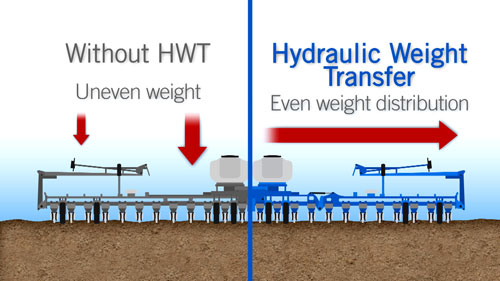Planters today are much bigger – with more rows and higher seed and fertilizer capacity. For the most part, this is a good thing because it allows growers to plant more acres per day and reduce the amount of time it takes to fill the planter.
The major drawback to bulk fill planters is how the majority of the planter’s weight is centered above the middle rows. This intensifies the impact of soil compaction, which often leads to stunted plant growth. “Soil compaction is a major issue and can directly impact crop yield,” said Kinze district sales manager Mike Gryp. “Many farmers are concerned about soil compaction and making an effort to reduce the negative impact.”

To help farmers overcome this challenge and enjoy the benefits of bulk fill planters, Kinze developed the Hydraulic Weight Transfer system, an exclusive in the industry available only on Kinze planters. Here’s how it works: the weight transfer system applies consistent down pressure to the wings on its own so there is no need for adjustments to the system by the farmer while planting.“A great benefit of Hydraulic Weight Transfer is the assistance in helping to keep the frame level, which helps keep the wings in the ground (even in tougher terrains where it’s very difficult to keep the outer row units in the ground and at even depths),” said Gryp. “If the wings of the planter can’t stay in the ground, the planting depth is compromised and emergence is often uneven, which normally leads to a loss in yield.”
Gryp said farmers regularly identify even emergence as one of the keys to maximizing yield. Unfortunately, he said, the weight distribution issues of many bulk fill planters has led some farmers to accept uneven emergence as a reality of growing. “Many of them simply plant and accept the yield loss, which is unfortunate,” Gryp said.
There’s no need for this, according to Gryp. So when one of his customers expresses concerns about the weight of bulk fill planters and the impact uneven weight distribution has on yield, Gryp will put them in touch with somebody who can speak firsthand about the performance benefits of the Hydraulic Weight Transfer system.
“Most of my customers speak very highly about the Hydraulic Weight Transfer system and say they see a noticeable difference in their emergence,” said Gryp. “Some other customers say they are afraid of bulk fill planters because of the weight…All I do is get them in touch with someone in their community who had the same concerns and now uses a Kinze bulk fill planter with Hydraulic Weight Transfer.”
To be sure, the benefits of Hydraulic Weight Transfer are worth talking about.
